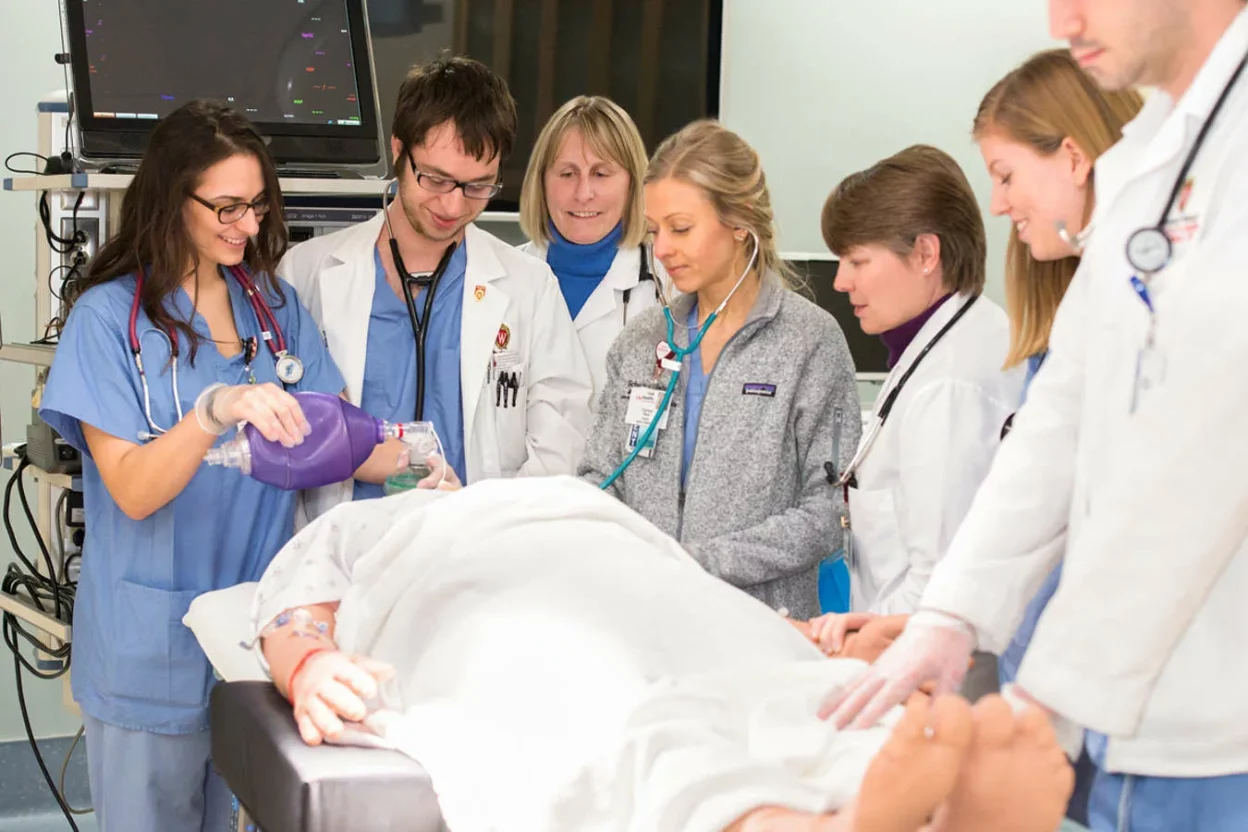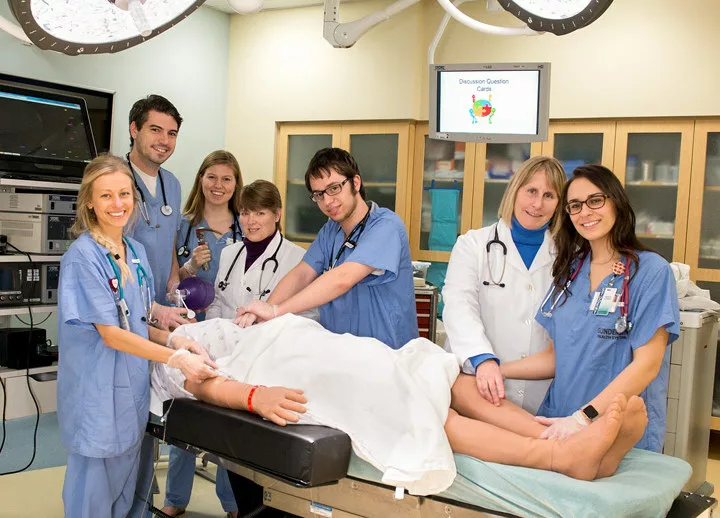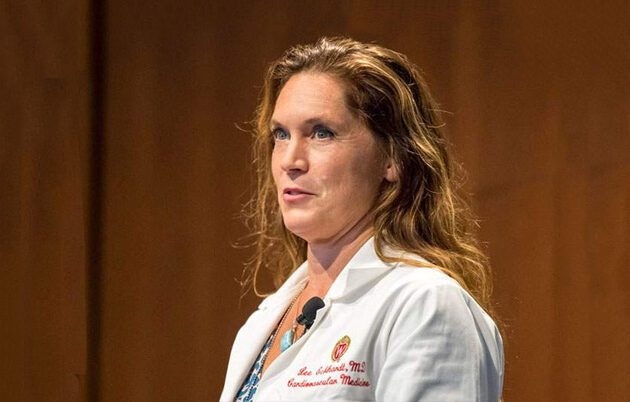Development of the new curriculum was a multi-year process that involved hundreds of SMPH faculty and staff members. Lansing joined the teams that developed the Care Across the Lifecycle Block and the Chronic and Preventive Care Block, which fit well with her family medicine training and her basic science background. In the legacy curriculum, basic science had consumed only the first two years of medical education.
“In Phase I of the ForWard Curriculum, this stage is condensed to a year and a half, which means some basic science is purposefully woven into Phase 2,” Lansing says. “I found that my experience as a basic science researcher and teacher was helpful in that integration.”
Describing curriculum design as her “hobby,” Lansing came well prepared to the task. She recalls writing her first course in 1992, then years later being in on the ground floor of the school’s innovative WARM program.
When the school created WARM and selected La Crosse as one of its training sites in 2007, program planners asked Lansing to help develop the curriculum. In addition to the more traditional components, she introduced disaster training, which became a case-based, simulation-driven, hands-on activity of the kind that animates much of Phase 2 of the ForWard Curriculum. She and other staff involve students in planning disaster drills with local firefighters and paramedics. For the exercises, they’re broken into rescue squads and role-play the experience of responding in the field to rural scenarios such as a tractor rollover or city events such as an active shooter at an airport. The students gain a realistic sense of how disasters are managed in the field and how patients are assessed, treated and prepped for transport. The airport shooter scenario was so successful that it was filmed, and portions of the video have been used in training for Transportation Security Administration workers in Washington, DC.
For her part, Lee worked for years on the Curriculum Transformation Steering Committee led by Christine Seibert, MD, associate dean for medical student education and services, and Shobhina Chheda, MD, MPH, associate dean for education. Now implementing the Acute Care Block, designed by Laura Zakowski, MD ’90, professor of medicine, and other SMPH faculty partners, Lee describes the kick off of the block experience with enthusiasm.
“The transformation afforded an opportunity to create a whole new curriculum. I had always attempted to achieve integrated learning in my own way as a preceptor—but now we have an exciting, cohesive approach to medical training that teaches medical facts and concepts within the context of patient-centered care delivery and collaborative professional teamwork.”
Early Signs Are Positive
Although this part of the curriculum “went live” only on January 8, 2018, Lee already is seeing encouraging signs. In the early weeks, students in the acute care block participated in preceptor sessions that exposed them to cases requiring differential diagnosis of chest pain. That was followed by a radiology session involving scans of patients with chest pain and simulations of chest-pain cases in the simulation lab in Gundersen’s Integrated Center for Education.
Shortly thereafter, during clinical time in internal medicine, the students were presented with two real-time cases of patients who had arrived in the emergency room with chest pain. When the supervising physician asked students to prepare a care plan based on the history and clinical findings of the patients, he was impressed with the appropriateness and completeness of the plan one of the students produced.
“How did you come up with this plan?” he inquired, to which the student replied, “I based it on the clinical case presentations and simulations we did last week.”
Lee notes, “That’s exactly what we’re trying to achieve. The goal is to expose students to material in case-based learning situations, and weave together multidisciplinary medical facts and concepts in the context of care delivery so they can immediately begin to apply that knowledge in real patient care situations.”
Certified in palliative care as well as general internal medicine, Lee believes strongly in the importance of bringing empathy not only to patient care, but also to the student experience.
“Learning has to be a safe space that’s inclusive of different learning styles,” she says. “Studies show those who learn empathy as students keep it as doctors. I like to get to know them and figure out what makes them tick, just as we do with patients.”
Top-notch Mentorship
Lee and Lansing’s attitudes are among the reasons they received the SMPH Dean’s Teaching Award in 2014 and 2009, respectively. Lansing also was named a fellow in the UW–Madison Teaching Academy.
Both Lee and Lansing are relishing the opportunity to incorporate innovative educational technologies into the ForWard Curriculum. Working with medical media experts at Gundersen, they’ve created videos that some students are asked to watch in preparation for class. They’re working on electronic cases, modeled after the electronic health record. Students may enter a case as if they are opening a patient’s chart. There the students might watch a video of an initial patient interview, then be asked to enter orders and notes into the simulated chart. If they enter a lab or medication order, a lab technician could pop up on the video to discuss the test, or a pharmacist could chime in to discuss the drug choice. Opportunities for innovation seem limitless.
Lee and Lansing quickly credit the strength of Gundersen’s leadership team, which supported their efforts. They add that Greg Thompson, MD, director of medical education at Gundersen and the associate dean for the SMPH’s Western Academic Campus, is unrelenting in the pursuit of a respectful, compassionate learning culture.
“Our students also have tremendous energy and care from our program coordinators Allyson Servais and Pam Schneider,” shares Lee.
Not surprisingly, she and Lansing were tasked with ensuring a smooth rollout of Phase 2 at Gundersen. That process is well underway, but they are not resting on their laurels. They seem to embody Aristotle’s oft-quoted observation: “Those who know, do. Those who understand, teach.”
“ForWard is more than a curriculum of facts,” says Lee. “It has all the science, presented in a way that prioritizes the health of patients and communities.”
Lansing adds, “The new curriculum stresses the interdisciplinary nature of care. The whole ForWard Curriculum emphasizes how we all work together for patients.”



